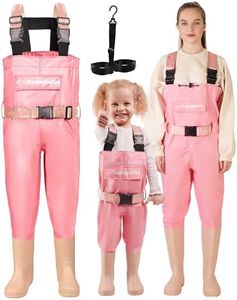We Use CookiesWe use cookies to enhance the security, performance,
functionality and for analytical and promotional activities. By continuing to browse this site you
are agreeing to our privacy policy
10 Best Surf Waders
From leading brands and best sellers available on the web.Buying Guide for the Best Surf Waders
Choosing the best surf waders is all about matching your needs with their key features so you can stay comfortable, dry, and safe while fishing or walking in surf conditions. Knowing where and how you plan to use your waders will help you decide which attributes matter most. By focusing on the main specifications and understanding what they mean, you can easily navigate the options and pick the best pair for your style and environment.MaterialThe material of surf waders determines how durable, breathable, and waterproof they will be. Common materials include neoprene, nylon, and breathable fabrics. Neoprene is thicker, keeps you warmer, and is great for colder waters, but it may get hot in warm weather. Nylon and breathable fabrics are lighter and let moisture escape, which is perfect for milder climates or more active fishing. Think about the temperature and comfort you'll need: if you'll be in cold surf, sturdier, insulated material is helpful, but for warmer conditions, light and breathable fabrics are a better fit.
Wader StyleWader style refers to how high the waders come up your body: hip, waist, or chest. Chest waders provide the most coverage and protection against deep water and splashes, making them suitable for surf fishing where waves can rise unexpectedly. Waist-high and hip waders are lighter and less restrictive but offer less protection, so they are ideal if you’ll mostly be in shallow water. Choose the wader height based on how deep you expect to go and how much freedom and warmth you want.
Bootfoot vs. StockingfootWaders either come with integrated boots (bootfoot) or end with socks for use with separate wading boots (stockingfoot). Bootfoot waders are convenient and easy to slip on, perfect if you don’t want the hassle of separate shoes. They are also better for cold weather since there are fewer openings for water. Stockingfoot waders require separate boots, offering a better fit and more ankle support, especially if you’re walking long distances over rough terrain. Your choice depends on your priorities—ease of use and warmth versus customization and support.
Seam ConstructionSeam construction is about how the wader panels are joined together, which affects how waterproof and durable the waders are. Welded or taped seams tend to be more reliable at keeping water out compared to stitched seams, which may eventually leak. If you plan on spending long hours in the water or expect to be exposed to a lot of movement and stress, look for reinforced, waterproof seams. Anyone occasionally fishing might be fine with simpler seams, while frequent anglers should prioritize the strongest construction.
Fit and SizeThe fit and sizing of your surf waders are crucial for comfort and performance. Waders that are too tight will be restrictive, while those too loose can cause chafing and get in your way. Many manufacturers provide size charts; it’s important to consider both the width and the length, and if you’ll be wearing extra layers underneath. Always try on or carefully check reviews about sizing—choose a fit that leaves you room to move but doesn’t feel baggy, balancing protection and comfort according to how much activity you plan.
















